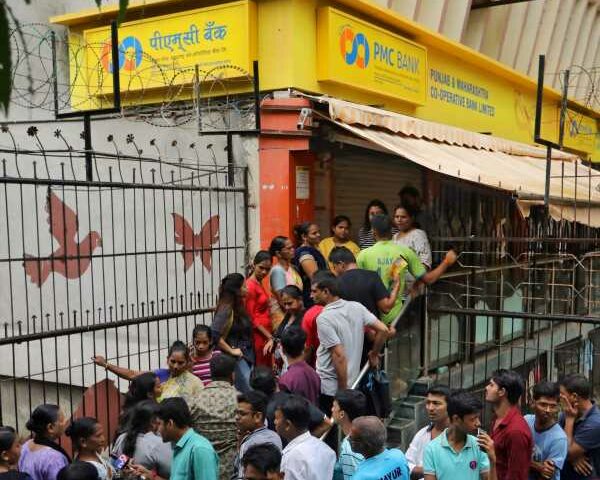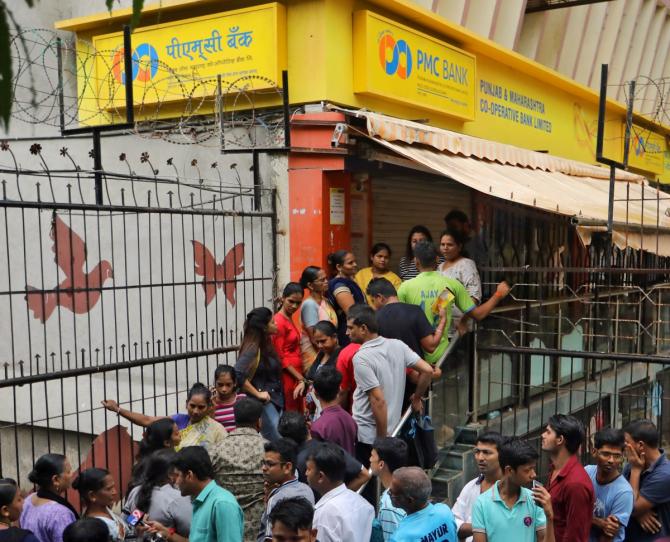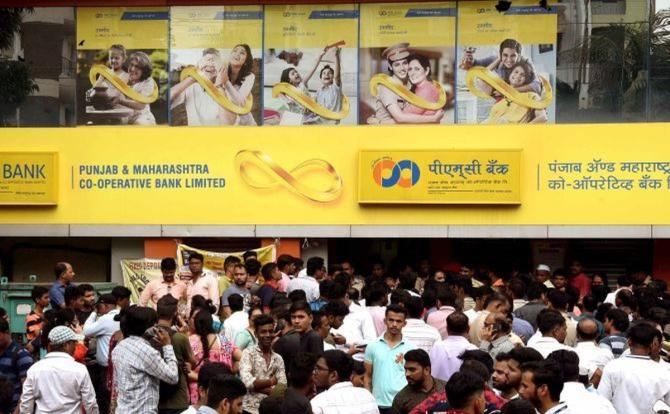There will be different ways of returning the money, depending on the profile of the depositors and the amount, predicts Tamal Bandyopadhyay.
Hundreds of employees of Centrum Financial Services Ltd and Resilient Innovations Pvt Ltd (better known for its brand BharatPe) have been busy these days in search of a name for the small finance bank that these two companies are setting up as a 50.10-49.90 per cent joint venture.
The Reserve Bank of India has given in-principle approval for the new bank with an explicit understanding that Punjab and Maharashtra Cooperative (PMC) Bank, under moratorium since September 2019, will be merged with it.
Jaspal Bindra, the Centrum group boss, and Ashneer Grover, co-founder of Resilient Innovations, are the white knights tasked with rescuing the depositors of PMC Bank and its 1,200 employees.
Typically, a failed cooperative bank goes for liquidation. This is the first instance of one being saved through a merger.
In 1995, a cooperative bank got the licence to become a universal bank; recently an urban cooperative bank has got the RBI nod to become a small finance bank.
But in none of these cases, they were sinking the way the fraud-hit PMC Bank is.
This has been possible following the June 2020 amendment to the Banking Regulation Act, which has brought cooperative banks under the regulatory ambit of the RBI.
PMC Bank will be merged with the new entity, which will commence operations within 120 days of getting the in-principle licence from the RBI.
Under Section 45 of the Banking Regulation Act, a merger scheme will be drafted for public comments before the central government clears it.
The key question is: What’s there for PMC Bank depositors?
On September 23, 2019, the RBI superseded the PMC Bank’s board, appointed an administrator and capped deposit withdrawal at Rs 1,000.
The withdrawal limit had been raised in phases to Rs 100,000 in June 2020, allowing 84 per cent of the bank’s close to 950,000 depositors to withdraw their entire deposit. Recently, the RBI extended this arrangement till December 31.
In March 2020, PMC Bank had a deposit portfolio of Rs 10,727 crore (Rs 107.27 billion), advances of Rs 4,473 crore (Rs 44.73 billion), gross bad loans of Rs 3,519 crore (Rs 35.19 billion) and a capital of Rs 293 crore (Rs 2.93 billion).
By September 2020, the deposit kitty shrank to Rs 10,500 crore (Rs 105 billion). A Rs 6,835-crore (Rs 68.35 billion) loss in financial year 2020 has drilled a Rs 5,851-crore (Rs 58.51 billion) hole in its net worth.
About 30 per cent of its depositors make for 92 per cent share of deposits. The remaining 70 per cent kept Rs 25,000 or even less — overall, just Rs 898 crore (Rs 8.98 billion) out of a Rs 11,617-crore (Rs 116.17 billion) deposit when PMC Bank was put under moratorium. They have taken their money out.
Deposit of up to Rs 500,000 enjoys an insurance cover. This can take care of around Rs 4,000 crore, leaving a Rs 6,500-crore (Rs 65 billion) hole.
Only around Rs 1,000 crore (Rs 10 billion) loans of PMC Bank are good, and another Rs 500 crore (Rs 5 billion) of bad loans can be recovered.
Besides, PMC Bank has a Rs 2,000-crore government bond portfolio.
Even if we add the value of physical assets such as branches, around Rs 4,000 crore can be generated overall.
That leaves a Rs 6,500-crore hole (Rs 10,500 crore deposit liability minus Rs 4,000 crore assets).
That’s in theory; since PMC Bank is being merged with the new bank, its branch premises will not be sold.
The promoters of the new bank have committed Rs 1,800 crore (Rs 18 billion) in phases.
Then, how will the depositors get their money back?
While we need to wait till the merger scheme is prepared, my guess is there will be different ways of returning the money, depending on the profile of the depositors and the amount.
There are retail depositors as well as institutions, including academic entities, trusts, religious bodies and other cooperative banks.
Indeed, a deposit of up to Rs 5 lakh is insured by the Deposit Insurance and Credit Guarantee Corporation (DICGC) but the cover is available only when a bank is liquidated.
In this case, DICGC can at best give liquidity support in the form of a loan.
Armed with that, the bank will probably redeem the deposits through staggered payments, and part of it can be converted into equity.
The payment slabs can also be linked to recovery of bad loans. Besides, there should be a freezing date for interest payment of deposits.
It’s a fairly complicated exercise, but full redemption doesn’t seem to be guaranteed.
What will happen to the equity holders?
On merger, Rs 293 crore (Rs 2.93 billion) equity of PMC Bank will be extinguished. Will any of them get anything? It’s highly unlikely.
Why did Bindra commit to take over PMC Bank to set up a new bank — that too a small finance bank? Centrum’s partner, the payment applications company, is well versed with technology, and Bindra is a global banker.
In his last assignment, he was group chief executive director and chief executive officer for Asia Pacific at Standard Chartered Bank.
Between them, they have committed Rs 1,800 crore, nine times the capital requirement of a small finance bank.
They could have even applied for a universal bank, the licence for which is on tap now.
They know the answer, but this route probably cuts down the time.
A new bank cannot be set up before two years and there is no guarantee that their application will get the regulator’s nod.
This venture, however, will take off by December. Besides, it is getting 137 branches (40 premises are owned by PMC Bank).
PMC Bank also has a modern core banking solution (of Infosys Ltd) in place.
What kind of business will this bank do? A small finance bank needs to devote 75 per cent of its loan book to small loans — no more than Rs 25 lakh (Rs 2.5 million) each.
The plan seems to be to run a retail bank to give small loans only, capping the amount at Rs 25 lakh for all loans.
The focus could be on gold loans and personal loans, among other products.
Two group companies of Centrum now give micro loans and home loans, while the third company, which has been into medium and small enterprise financing, is being converted into a bank.
It has around Rs 1,000 crore loan assets, and BharatPe has Rs 1,600 crore (Rs 16 billion) loan assets under management.
It will be a digital bank. While all loans will be disbursed digitally, deposits will be collected at branches — 150 to start with, including 13 of Centrum.
People familiar with the plan say this is a technology company that will also do banking.
Since it can’t be called Restoration Bank, let’s call it Tech Bank, for now. I am sure the employees will settle for a better name.
Tamal Bandyopadhyay, consulting editor with Business Standard, is an author and senior adviser to Jana Small Finance Bank Ltd.
Feature Presentation: Rajesh Alva/Rediff.com
Source: Read Full Article




